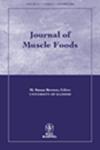EFFECTS OF CASEINATE, WHEY AND MILK PROTEINS ON EMULSIFIED BEEF MEAT BATTERS PREPARED WITH DIFFERENT PROTEIN LEVELS
Abstract
ABSTRACT
The effects of meat protein substitution (2%) with sodium caseinate, milk protein isolates or whey protein isolates (WPI) at varying levels of meat protein (13–15%) were studied in emulsified beef meat batters prepared with canola oil (25%). Increasing meat protein to 14 and 15% resulted in less stable emulsions (higher cook loss) compared with the 13% protein. At an equal protein level, all dairy proteins reduced cook loss (P < 0.05) compared with the all meat protein treatments. Overall, WPI provided the best emulsifying and moisture retention. Increasing the protein content also resulted in higher hardness and springiness values in all treatments. The addition of dairy protein resulted in softer, lighter and less red products compared with the all meat controls; colors being affected by the dairy protein source and protein content. Light microscopy revealed that increasing protein content caused some fat globule coalescence and more protein aggregation. WPI formed distinct dairy protein gel regions within the meat batter matrix, which appeared to interact with meat protein matrix.
PRACTICAL APPLICATIONS
The main goal of this study was to understand the effects of partially substituting meat proteins with dairy proteins on the performance (cook loss and textural properties) of comminuted meat batters prepared with canola oil. The incorporation of canola oil, instead of animal fat, offers a new healthy alternative to the consumer but has its challenges in terms of keeping this liquid oil (high unsaturation level) within the meat product).

 求助内容:
求助内容: 应助结果提醒方式:
应助结果提醒方式:


